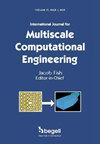Fine-tuning MobileNetV3 with different weight optimization algorithms for classification of denoised blood cell images using convolutional neural network
IF 1.4
4区 工程技术
Q2 ENGINEERING, MULTIDISCIPLINARY
International Journal for Multiscale Computational Engineering
Pub Date : 2024-02-01
DOI:10.1615/intjmultcompeng.2024051541
引用次数: 0
Abstract
A novel method based on convolutional neural networks (CNNs) to denoise the blood cell images (BCI) is proposed in this paper. CNN is a kind of deep learning technique that specializes in retrieving information from input images instantly and capability to reduce the need for expert knowledge when extracting and selecting features. Hyper parameters like activation functions can have a direct impact on the model's performance in CNN. Hence this paper introduced a novel Improved Rectified Linear Units (I-ReLU)-CNNs approach for denoising the BCI images. In addition, the modified-ReLU and NRMSprop are the two techniques used to fine-tune the MobileNetV3 model. Then this fine-tuned MobileNetV3 model is applied for the feature extraction to remove the unwanted features from the original images. Then the Artificial Hummingbird Algorithm (AHA) based on the Manta Ray Foraging optimization algorithm (MRFOA) is proposed for feature selection. Moreover, this AHA-MRFOA is employed to ensure the development of the overall model classification by choosing only the most essential elements. The proposed model is evaluated based on the blood cell image dataset and achieves 97.86% classification accuracy.使用不同权重优化算法微调 MobileNetV3,利用卷积神经网络对去噪血细胞图像进行分类
本文提出了一种基于卷积神经网络(CNN)的去噪血细胞图像(BCI)的新方法。卷积神经网络是一种深度学习技术,专门从输入图像中即时检索信息,在提取和选择特征时能够减少对专业知识的需求。激活函数等超参数会直接影响 CNN 模型的性能。因此,本文介绍了一种新颖的改进整流线性单元(I-ReLU)-CNNs 方法,用于对 BCI 图像进行去噪。此外,改进的线性单元(I-ReLU)和 NRMSprop 是用于微调 MobileNetV3 模型的两种技术。然后将微调后的 MobileNetV3 模型用于特征提取,以去除原始图像中不需要的特征。然后提出基于蝠鲼觅食优化算法(MRFOA)的人工蜂鸟算法(AHA)来进行特征选择。此外,该 AHA-MRFOA 算法只选择最基本的元素,以确保整体模型分类的发展。基于血细胞图像数据集对所提出的模型进行了评估,其分类准确率达到了 97.86%。
本文章由计算机程序翻译,如有差异,请以英文原文为准。
求助全文
约1分钟内获得全文
求助全文
来源期刊
CiteScore
3.40
自引率
14.30%
发文量
44
审稿时长
>12 weeks
期刊介绍:
The aim of the journal is to advance the research and practice in diverse areas of Multiscale Computational Science and Engineering. The journal will publish original papers and educational articles of general value to the field that will bridge the gap between modeling, simulation and design of products based on multiscale principles. The scope of the journal includes papers concerned with bridging of physical scales, ranging from the atomic level to full scale products and problems involving multiple physical processes interacting at multiple spatial and temporal scales. The emerging areas of computational nanotechnology and computational biotechnology and computational energy sciences are of particular interest to the journal. The journal is intended to be of interest and use to researchers and practitioners in academic, governmental and industrial communities.

 求助内容:
求助内容: 应助结果提醒方式:
应助结果提醒方式:


